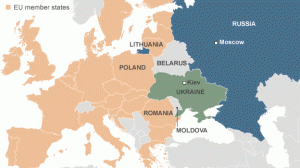Watching the escalating events in Ukraine, where a full-blown civil war is underway, it is very easy to forget the decision that sparked these events.
November 21, 2013, then Ukrainian President, Viktor Yanukovych, announced that his government was abandoning plans to sign an association agreement that would begin the process of strengthening ties with the European Union (EU). Within two months, protests against this decision had led to his forced resignation.
For a significant portion of Ukrainians, closer ties with the EU represent, among other things, a move toward a less corrupt society. The EU is more than a trade bloc. The association agreement signed by the new Ukrainian government with the EU includes an agenda for reforms to support the country’s economic recovery and governance.
For the Russian powers-that-be, one can only speculate that the same move represents a start down the path that has already been taken by Albania, Poland, Romania and other former communist Eastern European countries. Today, these countries are not just members of the European Union, but also of the North Atlantic Treaty Organization (NATO).
NATO is a political and military alliance comprising 28 countries, including the United States. Among other provisions, the North Atlantic Treaty states that an armed attack against one NATO member is considered an attack against all members, requiring them to come to the assistance of the attacked member. Created in 1949, the expected attacker was the precursor to today’s Russia – the Soviet Union.
The Soviet Union’s response to NATO was the Warsaw Pact, also created as a collective defense treaty that would bring its members to the defense of any one that was attacked. In this case, the expected attacker was the United States and its NATO allies. Defunct since the collapse of the Soviet Union, Warsaw Pact members included – Albania, Poland, Romania, and other former communist Eastern European countries. As a part of the territory of the Soviet Union, Ukraine was by default, also a part of the Warsaw Pact.
Today, NATO lives on. All EU members are not NATO members. However, all former Eastern Europe Warsaw Pact members are now NATO members.
The Cold War is ostensibly over, but apparently not for Russia. The steps taken by Ukraine that bring it closer to the EU are apparently being viewed through the cold war prism. Ukrainians deserve the right to choose their own way forward.
Perhaps, however, the United States and the EU have a role to play in de-escalating the rising tensions 
by acknowledging that EU membership, particularly when elected by a
former Soviet republic, is about more than trade.